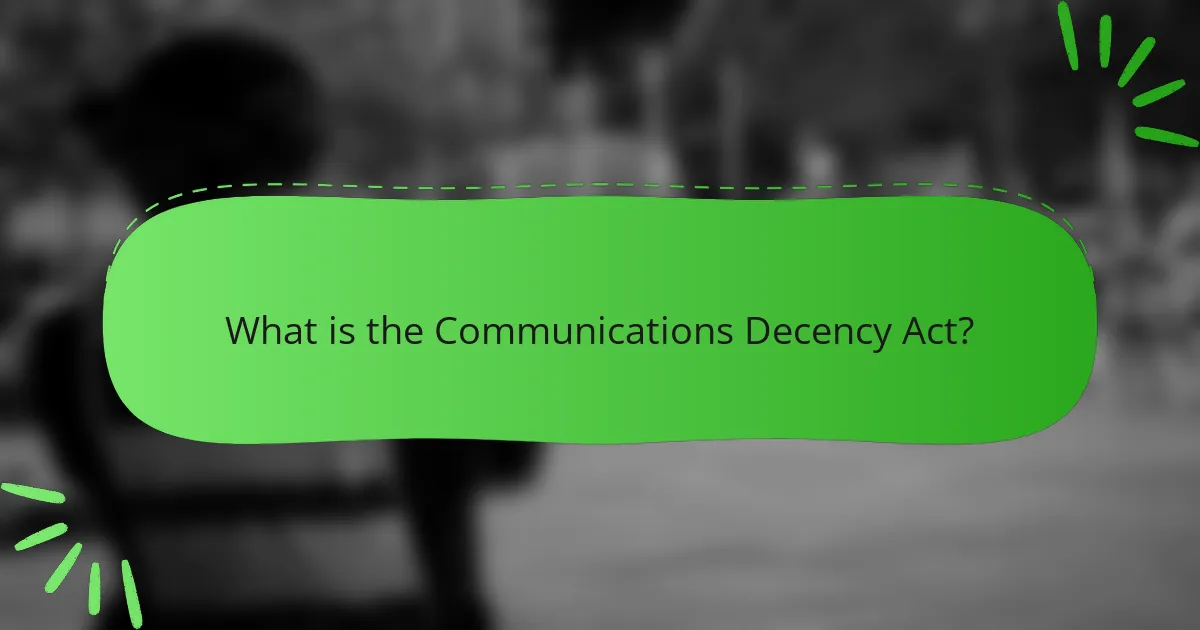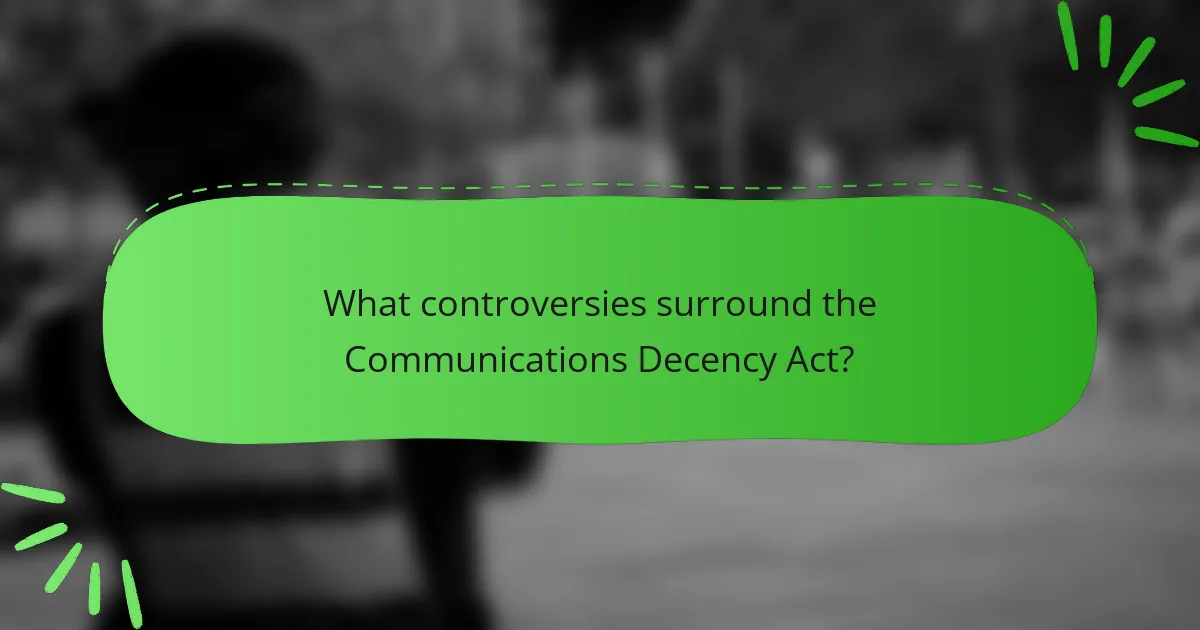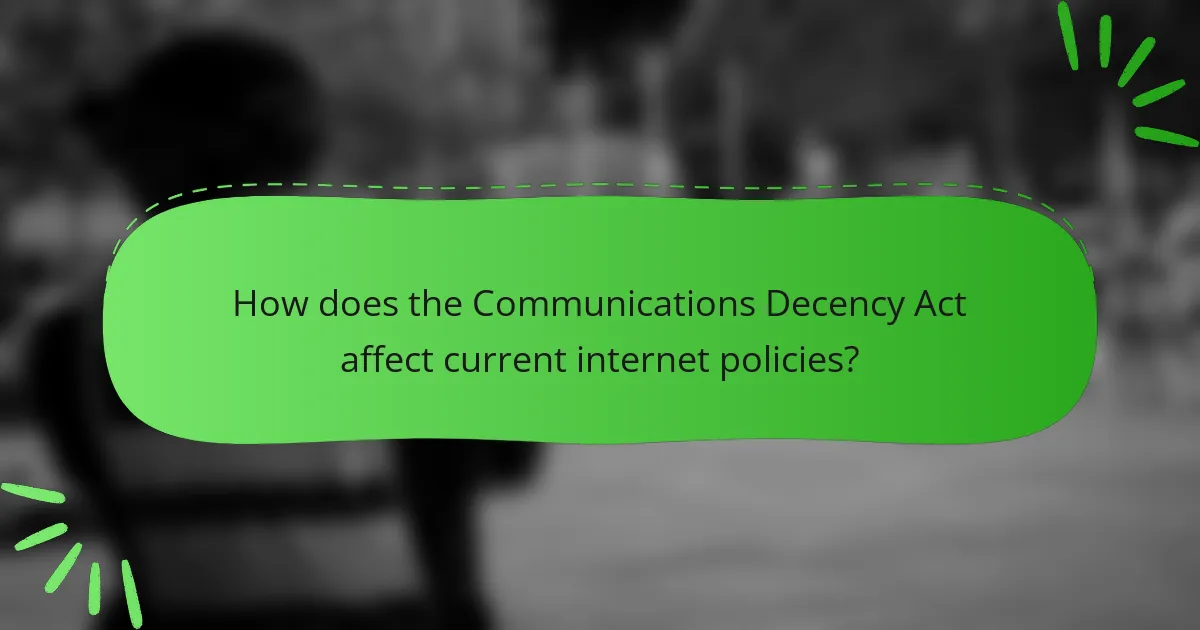The Communications Decency Act (CDA) is a U.S. law established in 1996 aimed at regulating online content and protecting minors from harmful materials. A key component of the CDA is Section 230, which grants online platforms immunity from liability for user-generated content. The article examines the implications of the CDA, particularly the controversies surrounding Section 230, which has sparked debates about free speech, the spread of harmful content, and the responsibilities of online platforms. Legal challenges have tested the boundaries of this law, influencing how companies approach content moderation and shaping current internet policies. The ongoing discussion highlights the complex balance between user expression and platform accountability in the digital landscape.

What is the Communications Decency Act?
The Communications Decency Act (CDA) is a U.S. law enacted in 1996. It was designed to regulate online content and protect minors from harmful materials. The CDA includes provisions that criminalize the transmission of obscene or indecent messages. It also aimed to promote the development of technologies that protect children from inappropriate content. One significant aspect of the CDA is Section 230. This section provides immunity to online platforms from liability for user-generated content. The CDA has been the subject of numerous legal challenges and debates. Critics argue it limits free speech, while supporters claim it is essential for internet safety.
How did the Communications Decency Act come into existence?
The Communications Decency Act (CDA) was enacted in 1996 as part of the Telecommunications Act. It aimed to regulate online content and protect minors from harmful material. The act was introduced amid growing concerns about the internet’s impact on society. Lawmakers sought to create standards for online behavior and content. The CDA included provisions that criminalized the transmission of obscene materials to minors. However, several sections were challenged in court for being overly broad. The Supreme Court ultimately struck down key provisions in 1997, declaring them unconstitutional. This led to ongoing debates about free speech and online regulation.
What were the key motivations behind the enactment of the Communications Decency Act?
The key motivations behind the enactment of the Communications Decency Act (CDA) were to protect minors from harmful online content and to promote safe internet usage. The CDA aimed to address concerns about the proliferation of obscene materials on the internet. Congress sought to establish regulations that would limit access to indecent content for children. The law reflected a growing anxiety over the impact of the internet on youth. Additionally, lawmakers wanted to encourage the development of online platforms while ensuring user safety. The CDA was passed in 1996 amid rising public pressure for regulatory measures. It was a response to the rapid expansion of the internet and the challenges it posed.
What historical context influenced the development of the Communications Decency Act?
The historical context influencing the development of the Communications Decency Act (CDA) includes the rise of the internet and concerns about online content. In the mid-1990s, the internet began to expand rapidly, leading to increased access to explicit materials. This prompted public outcry regarding the exposure of minors to harmful content. Legislative efforts aimed to regulate indecent material online emerged in response to these concerns. The CDA was enacted in 1996 as part of the Telecommunications Act. It aimed to protect children from inappropriate online content while balancing free speech rights. The law faced significant legal challenges, leading to Supreme Court scrutiny in 1997. Ultimately, parts of the CDA were struck down for violating the First Amendment. This historical backdrop highlights the tension between content regulation and free expression.
What are the main provisions of the Communications Decency Act?
The main provisions of the Communications Decency Act include Section 230 and provisions related to indecent material. Section 230 provides immunity to online platforms from liability for user-generated content. This means platforms are not responsible for what users post. The Act also aimed to restrict access to indecent material online. It sought to protect minors from harmful content. However, some provisions were struck down by the courts. The Supreme Court ruled that certain restrictions violated free speech rights. Overall, the Act established a framework for internet regulation. It significantly shaped online communication and platform responsibilities.
What specific protections does the Communications Decency Act provide to online platforms?
The Communications Decency Act (CDA) provides specific protections to online platforms under Section 230. This section shields platforms from liability for user-generated content. It allows platforms to moderate content without being deemed publishers. This means they can remove harmful material without facing legal repercussions. The law was enacted in 1996 to promote free speech online. It has been upheld in numerous court cases, reinforcing its protections. For instance, the case of Zeran v. America Online established that platforms are not liable for defamatory statements made by users. Overall, Section 230 is crucial for the functioning of the internet as we know it today.
How does the Communications Decency Act address harmful content online?
The Communications Decency Act (CDA) primarily addresses harmful content online through Section 230. This section provides immunity to online platforms from liability for user-generated content. It protects websites from being held responsible for the harmful actions of their users. The CDA encourages platforms to moderate content without fear of legal repercussions. This legal framework has been pivotal in shaping the internet’s landscape. It allows for the removal of obscene or harmful materials while safeguarding free speech. Section 230 has been cited in numerous court cases, reinforcing its importance in internet law.

What controversies surround the Communications Decency Act?
The Communications Decency Act (CDA) has faced significant controversies primarily surrounding its Section 230. This section provides immunity to online platforms from liability for user-generated content. Critics argue this immunity enables the spread of harmful content, including hate speech and misinformation. Advocates claim it is essential for free speech and innovation on the internet. Legal challenges have emerged questioning the balance between protecting users and promoting free expression. Notably, multiple court cases have tested the limits of Section 230, impacting its interpretation. The ongoing debate highlights the tension between regulation and freedom in the digital age.
Why is Section 230 of the Communications Decency Act considered controversial?
Section 230 of the Communications Decency Act is considered controversial because it provides broad immunity to online platforms from liability for user-generated content. Critics argue that this immunity allows platforms to avoid accountability for harmful content, such as hate speech or misinformation. Proponents believe it is essential for free speech and innovation online. The debate intensified with high-profile cases involving misinformation and harassment. Some lawmakers seek to amend or repeal Section 230 to hold platforms more accountable. According to a 2020 survey by the Pew Research Center, 54% of Americans believe social media platforms should be held responsible for the content they host. This ongoing tension reflects the challenges of balancing free speech and user safety in the digital age.
What are the arguments for and against Section 230?
Section 230 provides legal protection for online platforms from liability for user-generated content. Supporters argue it promotes free speech and innovation by allowing platforms to host diverse content without fear of lawsuits. This protection encourages the growth of social media and other online services. Critics contend it enables harmful content to proliferate without accountability. They argue that it allows platforms to avoid responsibility for moderating harmful material. Additionally, some believe it creates a disparity in how different entities are treated under the law. The debate continues as lawmakers consider reforms to address these concerns.
How has Section 230 been interpreted by courts over time?
Section 230 has been interpreted by courts as providing broad immunity to online platforms for user-generated content. This interpretation began with the 1997 case Stratton Oakmont, Inc. v. Prodigy Services Co. The court ruled that Prodigy was not liable for defamatory statements made by users. Subsequent cases, such as Zeran v. America Online, reinforced this immunity, stating that platforms cannot be treated as publishers of user content. Courts have consistently emphasized that Section 230 protects platforms from liability for content moderation decisions. In recent years, however, some courts have begun to question the scope of this immunity. Cases like the 2020 decision in Doe v. Facebook, Inc. have explored the limits of Section 230 in relation to platform responsibility for harmful content. Overall, the interpretation of Section 230 has evolved, balancing protections for platforms and accountability for harmful content.
What impact has the Communications Decency Act had on free speech?
The Communications Decency Act (CDA) has had a significant impact on free speech online. The CDA, enacted in 1996, aimed to regulate indecent content on the internet. It introduced Section 230, which provides immunity to online platforms from liability for user-generated content. This protection allows platforms to host a wide range of speech without fear of legal repercussions. Critics argue that it enables the spread of harmful content, while supporters claim it fosters free expression. The CDA has shaped the landscape of online communication, balancing regulation and free speech. Legal cases have further defined its implications, influencing how platforms manage content.
How do critics argue that the Communications Decency Act limits free speech?
Critics argue that the Communications Decency Act (CDA) limits free speech by imposing overly broad regulations on online content. They contend that the CDA’s provisions, particularly Section 230, create a chilling effect on speech. This occurs as platforms may excessively censor content to avoid liability. Critics highlight that this leads to the removal of legitimate discourse and diverse opinions. The fear of legal repercussions can stifle user-generated content. Additionally, critics assert that the law disproportionately impacts marginalized voices. They argue that the vague language in the CDA leaves too much room for interpretation. This ambiguity can result in arbitrary content moderation practices that undermine free expression.
What are the implications of the Communications Decency Act for content moderation practices?
The Communications Decency Act (CDA) significantly impacts content moderation practices. It provides legal protections for online platforms against liability for user-generated content. Section 230 of the CDA allows platforms to remove content they consider inappropriate without facing legal repercussions. This encourages platforms to engage in proactive moderation. However, it also raises concerns about censorship and the balance between free speech and harmful content. Critics argue that the broad protections can lead to over-moderation. Overall, the CDA shapes how platforms approach content moderation, influencing their policies and practices.

How does the Communications Decency Act affect current internet policies?
The Communications Decency Act (CDA) significantly influences current internet policies. It provides legal protections for online platforms against liability for user-generated content. This means that websites are not responsible for what users post. The CDA encourages free speech by allowing platforms to moderate content without fear of legal repercussions. Section 230 of the CDA is particularly crucial, as it has been upheld in numerous court cases. It allows platforms to remove harmful content while maintaining immunity. This legal framework shapes how companies approach content moderation today. Overall, the CDA remains a cornerstone of internet policy, balancing user expression and platform responsibility.
What changes to the Communications Decency Act have been proposed recently?
Recent proposals to amend the Communications Decency Act include modifications to Section 230. Lawmakers aim to hold platforms accountable for harmful content. These changes suggest reducing immunity for platforms that fail to address illegal activities. Proposed legislation emphasizes the need for transparency in content moderation practices. Some proposals advocate for stricter regulations on user-generated content. The intent is to protect users from harassment and misinformation. These changes reflect ongoing debates about online safety and free speech.
What are the potential consequences of amending the Communications Decency Act?
Amending the Communications Decency Act may lead to increased liability for online platforms. This change could result in stricter moderation policies. Platforms might remove more content to avoid legal repercussions. Users could face reduced freedom of expression online. Smaller companies may struggle to comply with new regulations. This could lead to a decrease in competition in the digital space. Additionally, there might be challenges in defining harmful content. Courts may become overwhelmed with litigation related to content moderation disputes.
What best practices should online platforms follow in light of the Communications Decency Act?
Online platforms should implement content moderation policies to comply with the Communications Decency Act. These policies should clearly outline acceptable user behavior. Platforms must actively monitor user-generated content for harmful or illegal material. They should establish reporting mechanisms for users to flag inappropriate content. Transparency in moderation practices is essential for user trust. Platforms should provide users with clear guidelines on community standards. Regular training for moderation teams can enhance the effectiveness of content review. Compliance with legal regulations and user privacy must be prioritized.
How can platforms balance user safety and free expression under the Communications Decency Act?
Platforms can balance user safety and free expression under the Communications Decency Act by implementing robust content moderation policies. These policies should prioritize the removal of harmful content while allowing diverse viewpoints to be expressed. Transparency in moderation practices fosters trust among users. Clear guidelines help users understand what constitutes unacceptable content. Additionally, platforms can utilize user reporting systems to identify problematic material. Engaging with community feedback can enhance moderation effectiveness. Regular audits of content moderation processes can ensure compliance with safety standards. By leveraging technology, platforms can better identify harmful content without infringing on free expression rights. This approach aligns with the intent of the Communications Decency Act to protect both users and free speech.
The Communications Decency Act (CDA) is a U.S. law enacted in 1996 aimed at regulating online content and protecting minors from harmful materials. The article examines the CDA’s key provisions, including Section 230, which grants immunity to online platforms for user-generated content, and discusses the historical context that led to its creation. It also explores the controversies surrounding the CDA, particularly regarding free speech and content moderation practices, highlighting arguments for and against Section 230. Additionally, the article addresses recent proposals for amending the CDA and their potential implications for internet policies and user safety.